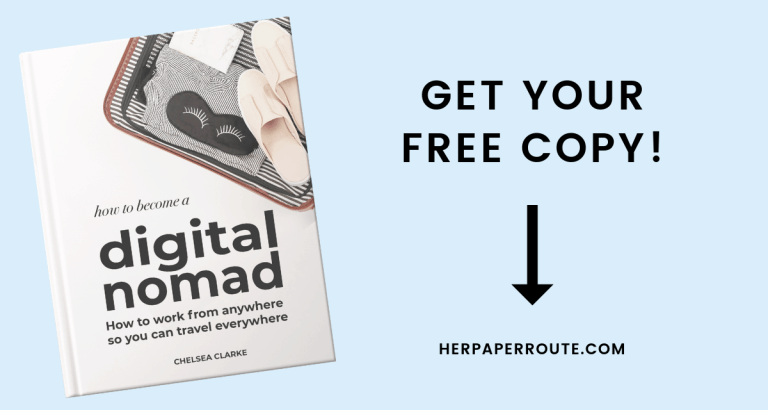How To Find Companies That Pay For Ideas [+ List of the Best]
You may be sitting on a gold mine of information right now. You’ve got an amazing idea that you want to sell and make money off of, but you don’t know where to start.
In fact, you may not know if there are companies that pay for ideas.
The good news is some companies pay for ideas. Now, you’ve just got to figure out which one to work with and learn more about protecting yourself so that the company doesn’t steal it from you.
I’m going to walk you through the entire process. This is a full guide, so it’s going to take a little time to get through it, but it’s worth it.
As an affiliate partner of various brands and sponsored content, HerPaperRoute may earn commission on qualifying purchases. Disclaimer | Advertise With Us
Types of Ideas that Companies Pay For
Most people think that an idea can only be a thing you can hold and use. While inventions like this are plentiful, there are many other options.
Companies that pay for ideas may be searching for new content for podcasts, videos, and much more. There are plenty of things to consider, and this list isn’t all-inclusive.
Here’s the short of it: if you can think it up and find a niche, there’s a company out there that is going to pay for that idea.
Inventions
The inventions section is where most of the ideas come from. An invention can be just about anything.
You may have thought up a new knife to cut eggs or have an idea for a chopper that peels.
Sometimes, the idea you have comes from something already out there. This means you have to make it unique so that you can patent it and get it out there.
Inventions come in all types and can help almost anyone. They can be niche products, such as those that only welders use or something designed specifically for the kitchen.
The things you come up with might be focused on the company employees or consumers.
Apps
You’ve probably heard the expression that “there’s an app for that.” App creators work nonstop to think of new things to benefit the company and the consumer.
Sometimes, you’re scrolling through the app store on your phone and realize that there’s nothing there that you can use. In this case, you’ve got an idea for a new app that could help thousands of people.
Most of those ideas don’t go anywhere because they’ve already been thought of or they’re too advanced for this time. Sometimes, the app industry doesn’t think it has the potential you believe it does, or there isn’t enough technology to make it happen.
The good news here is that you may not have what it takes to build an app from scratch, but a company does. If you can show what the app is going to do and how it’s going to improve lives, companies that pay for ideas are going to be all over it.
App creators usually use the ‘freemium’ model. This is where people can download and install the app for free, and it comes with basic functionality. If the user wants more, they must pay for additional features and upgrades.
Advertising is another way that apps make money. Display other company information within the app, and that business pays the other company each time. You see a bit of the profit if you choose royalties (more on that later).
The best apps are actually those that aren’t a profit source. They drive revenue for the business in other ways, such as creating brand loyalty, earning coverage, and increasing sales by having more call-ins.
People are free to use the app for whatever purpose, but they are choosing that brand and company above all others. Banks and credit card companies have created their fan bases by having account-specific apps.
Websites
Along with apps, there is always a way to improve a website. Most companies already have a site, but you can give them ideas on how to make it better or more navigable.
Alternatively, you may come up with a different website altogether where the business can promote its products and services.
Software
Software is what solves the world’s problems, at least in my opinion. You can find software to do anything, such as create business cards, do personal taxes, and so much more.
If you can think of software that hasn’t been invented yet that could benefit people (or companies), you can make a lot of money. Each time the software is downloaded, you get royalties.
There can be some minor points to work out, but the goal is that you make money from the software idea you came up with first.
Designs
Designs aren’t the same as inventions, which is why I included them separately. While you may be thinking of fashion designs and the like, I’m focused more on improving a design that’s already there.
This might be company-specific, but some companies might be willing to pay the licensor or pay for the patent to use it. Regardless, there are endless opportunities to perfect a current design of something to make it better and more interesting to potential buyers.
Top Companies that Pay for Inventions
Regardless of what market your invention falls under, companies that pay for ideas are sure to want it. They’re out to make money, too, and that idea might be exactly what they need right now. Here are some of the top companies willing to pay you for your invention:
1. 3M
3M sells items in countless categories. Though it primarily focuses on electronics and office supplies, it ventures into healthcare items and the like.
In fact, it always wants to expand product lines, so it welcomes any new idea submissions. Make sure to read the fine print when submitting and understand the payment process.
2. Henkel
Henkel is a well-known company that owns the company that produces Right Guard deodorant and Dial Soap. It has many subsidiary companies that sell products for in-home care, laundry, beauty care, and adhesive technology.
This company is highly interested in new ideas in those areas. You may have a new line of products or can fix existing processes, packaging, and formulations.
Interestingly, it specifies that it’s interested in ideas from customers and students in particular.
3. Sharper Image
You may have heard of Sharper Image. It offers the latest gadgets, toys, and other technology.
To stay ahead of its competition, it requires new ideas regularly. It has a full team dedicated to finding ideas that the public submits to them. When you go to submit yours, you need photos of the sample (if available), a description of the product, and any mock-up drawings you’ve made.
If you’ve already started selling items from your idea, such as on eBay or Etsy, it may pay for those. It doesn’t buy ideas sold to other companies, though.
4. Jokari Home Solutions
Jokari Home Solutions specializes in homewares with a highlight on storage solutions and kitchen gadgets. Don’t let that fool you because it describes itself as searching for new ideas continuously.
To start, you should visit their website and express interest. Someone from Jokari will reach out to you with more details on the process of idea submission.
5. Under Armor
Under Armor is by far the most well-known sporting apparel brand out there. It openly welcomes new product ideas from the public.
There is a detailed explanation of how to do it, but the instructions are easy to follow. Just make sure you read any fine print before giving any information about your product or idea.
6. Idea Buyer
If you’re looking for something unique, Idea Buyer might be the place to start. It helps you launch new product ideas, and some products are now sold in popular stores and online.
This company doesn’t develop your idea itself. Rather, it helps you find a market and willing companies to partner with.
Plus, it wants ideas about all types of products and inventions, so you’re not limited to a niche category.
The Best Companies that Buy App Ideas
With today’s focus being on smartphones and technology, products aren’t the only things that companies want to buy. They often focus on apps, too.
Whether you prefer to sell to a big name, such as Google, or something smaller, the options below might be interested in your big app idea:
Through the Google Play Store, you can actually sell apps you’ve developed already. If you don’t have an app and are in the idea stage, approach Google itself to see if it might be interested in investing to develop your app.
This is only available for game-changing apps. Those who think their idea might fit that bill could have a lucrative opportunity for themselves!
Mobile App Fund
Mobile App Fund is dedicated to finding new app ideas. It offers up to a million dollars per app for distribution, development, and marketing. You share the profits if it gets released to the public!
King
You may have heard of King, which is a developer for popular mobile games. Candy Crush is part of that, but you may not realize that it’s always interested in the next big thing.
If you’ve got an idea for a completely addictive game, consider reaching out to them.
Apple
Similar to the Google Play Store, Apple App Store might buy your developed app. If you think an idea might be worthy and make tons of money, reach out to the company directly.
It has been interested in buying app ideas, and it’s worth it if you can.
You Have an Idea that You Think You Can Get Paid For, Now What?
You’ve already come up with the perfect idea, and you just know it’s going to change the world. This is an exciting time.
I remember when I came up with my first idea and got it going. It was exhilarating and amazing. It’s not as easy as you might think, though.
The first thing to consider is creating it, marketing it, and doing it all on your own. You’ve probably decided that’s not what you want since you’re reading this, and that’s okay.
You can get paid for your idea by a company that decides to take it on and market it appropriately.
Do Market Research First
It’s important to perform market research. Find out if there is a need for your idea and if there are similar options already out there.
This is going to ensure that you’re not copying someone else and that companies are going to be willing to pay because it’s going to benefit consumers (or the company itself).
Once you know all there is to know about the idea and market, start searching for businesses that are within that niche.
Create A Pitch
Before contacting the company directly, create a pitch or angle. You’ve got to prove that the company is going to benefit in some way by showing how it’s going to help consumers.
It’s important to verify that the idea is going to do what it claims. There may be a few bugs to work out in the process, and the idea doesn’t have to be perfected right now. This isn’t the end-game. It’s just the start.
Once you have a pitch, contact company representatives. You may want to get the idea patented first, which I explain below. Now that you’ve got an outline of what to do let’s get into the nitty-gritty.
Can I Make Money from My Ideas?
Yes! You can make money from your ideas, and you don’t have to build a startup business to get it marketed.
Most people don’t know that there are companies that pay for ideas. You can license your invention idea.
This just means that you’re selling the idea to a company. It develops it fully and takes on all of the business-related tasks for launching a new product.
A Brief Overview of the Process
There are specific steps to follow and a right and wrong way of approaching the licensure of your invention. The first thing you’ve got to do is gather information. Before going to prospects to buy your idea, you’ve got to figure out a few things.
The first is to know your market. Gather feedback from your friends and family and maybe branch out for group testing. You should do this without revealing what your idea is if you’re afraid it may get poached.
Compile data on the competition and similar items. You must know what’s out there, who produces it, and what sells well.
Legal issues can arise during the process. Make sure that you know if your idea is patentable and hire a patent attorney to run everything by.
Have a patent attorney look into current patents to ensure that you’re not infringing on them. There are websites available where you can do preliminary patent searches.
When you have all this information and your lawyer has looked it over, you can present it to the company. Hopefully, the representative will be impressed with all the data you collected because it shows them that you are serious.
Though you aren’t going to produce it yourself, you should learn about the products’ production process. That way, you know rough costs about manufacturing techniques or unique materials needed.
Once you’ve gathered the relevant information necessary, you have to present it to the licensors. Remember, you haven’t looked into any companies that pay for ideas yet. You’re getting everything ‘legal’ so that the buyer can’t steal from you.
It’s important to have a three-dimensional prototype for items. Apps are a little different, and I’ll discuss them more below.
Ultimately, you’re creating a product spec sheet on the idea. Write up a one- to two-page document stating the problem or challenge that the product meets.
You can include benefits and features, the market for the item, and the legal status of it. If you don’t want to create a prototype, you should give a very clear description of what the object should look like and include sketches where possible.
Now is the time to develop introductory letters to provide to the licensor. Introduce yourself, explain why you’re contacting them, and list a time for a follow-up. Send all that to the right licensor, and you’re on your way.
While waiting for the licensing to come about, you can start pinpointing target companies to try to sell to. The more, the merrier here because most businesses are going to turn you down.
This is all a numbers game, and it’s nothing personal. Some companies might not want to take on a new product right now, and others might feel that it’s not a good fit.
I recommend having a list of 50 or more companies that pay for ideas. Now, you can prioritize them based on the best fit.
There are plenty of factors to focus on, such as the size of the business, where it’s located, and whether or not it has a similar line of apps or products.
You should keep in mind the reputation of the brand. Those that are more popular are going to sell better from the brand name alone.
You need to focus on how you’re going to get paid. An upfront payment might seem like the best option, but it often isn’t.
You and the company don’t know how well the idea is going to be. The company might lowball the offer, and you won’t see another dime, even if it becomes the most popular thing on the planet.
Later, I’m going to discuss payment through royalties, which I think is the better deal. That way, you’re getting a bit of the money sold for each unit.
How to Patent Your Idea or Invention
It isn’t technically possible to patent an idea. This is why you have to go through all the research and come up with sketches, 3-D models, or have full descriptions of the invention.
That way, it can be patented, and you can sell it without fear that it is going to get stolen.
My advice here is not to breathe a word of your idea to anyone else – even a spouse or close friend. If they get it in their head to patent it themselves, it’s a race against time, and you could end up losing out on the amazing thing you thought of first.
Most people don’t have the money to hire a lawyer, though I recommend doing this if you can. The patent-obtaining process can be very complex.
If another company claims that you stole its patented idea, you could have a complicated legal issue on your hands.
In most cases, though, you can file for a patent without an attorney, and that can save you a lot of money. Federal law requires the Patent and Trademark Office to help individuals who apply for a patent without a lawyer.
The first step is to make sure that the invention qualifies for a patent and fill out the application. Below, I lay everything out in a step-by-step process to make it easier for you:
1. Keep Written Records of the Invention
Use a notebook or an online document tool to record each step of your invention process. Describe each aspect and diagram everything thoroughly. If you make any modifications, include those with dates and reasons why you made changes.
If you’re using an online tool, print everything out each time and sign/date every entry. You may need witnesses to sign as well so make consult with a lawyer to be sure.
2. Ensure that the Invention Qualifies for a Patent
You can’t get a patent based solely on your idea. You’ve got to show the patent office how the invention works.
It has to be new, so it’s got to be different from similar items within that industry or field.
It costs money to file for a patent, so don’t waste time by not following the directions. Patent examiners are immediately going to reject the application if you can’t prove what it can do.
3. Assess Commercial Potential
Applying for the patent is just a business decision. Even if you don’t hire an attorney or use drawings prepared by a professional, you can pay thousands of dollars to file and get your patent.
Before making such an investment, research your market and decide if it’s all worth it. I am going to include a section later about patenting an idea when you don’t have money.
4. Conduct a Patent Search
It’s important to make sure the invention is completely new. To do that, investigate early developments in the field.
This means searching for patents from the US and maybe foreign ones and other publications, such as technical and scientific journals, to find anything related.
This is a time-consuming process, but it’s necessary, and you can master it with some practice. You could choose to hire a professional to do this later, but you know more about your idea than anyone, so you should start it.
Get on the internet, but go to the Patent and Trademark Depository library, too. This helps you search for early patents. You can get help from the librarian.
You’re likely to find inventions similar to yours. In the application, make sure you list those and show how yours improves on or is different from earlier ideas.
5. Prepare the Application and File it with the USPTO
When filing with the USPTO, there is a choice to make. File a full regular patent application or the provisional patent application.
The PPA isn’t an application for the actual patent. Filing this just means you can claim ‘patent pending’ status for your invention. It takes less work and money.
To file your PPA, you’ve got to pay a fee, which can be:
- $65 for a micro-entity
- $130 for a small entity
- $260 for a large company
*Fees change periodically so check with the actual USPTO for the most up-to-date fee listing.
You have to have a detailed description of your invention, explain how to make and use it, and give an informal drawing.
Once you’ve filed for the PPA, you must file the RPA within a year. If you don’t, you can’t claim the patent pending for that filing date.
Most inventors file the PPA to gain credibility fast and attract companies that pay for ideas.
If you choose to file the RPA first (or have already filed a PPA). You’ve got to start the examination process with the USPTO. This is necessary to get the actual patent.
There are several key elements for a patent. With the specification, several factors are used. They form the narrative that distinguishes and describes the invention.
This means that the invention is explained thoroughly so that knowledgeable people in the field of that invention can use and make it without more experimentation. You should describe here the best way to create and use it.
If you know how to make it and don’t provide that information, it can void the patent.
Within the specification, there’s the title, which must be short, descriptive, and accurate. Include the subject matter or field for the invention and describe any prior ones.
This is where your research pays off extensively. Point out problems with earlier products and how yours solves them.
You should summarize the invention, which is the overview of what it can do. Show how it’s going to solve the problems listed in the earlier section.
The last aspect is to describe the invention in a way that an ordinary person within that field can use it or follow it.
It doesn’t stop there. You’ve got to give detailed statements of what the invention does or covers.
This is highly important because the patent rights are based on what’s provided in the claims, so be very thorough and specific. You’ve got to include drawings if they are deemed necessary to show how the invention works. Drawings aren’t always required, though.
When you’ve got everything set up and written, you can file electronically or by mail. If any other information is needed, you can send that in or request amendments as required.
How Much Does It Cost to Patent an Idea?
Earlier, I described the prices for the patent-pending option, but here is the breakdown for the cost of a full patent.
You should expect to pay between $5,000 and $16,000, depending on the complexity of the invention. Simple designs cost roughly $5,000 to $7,000, while a complex one such as satellite technology or software could be in the range of $16,000 or more.
The basic cost for the application (to file) is $300 for a corporation. Since you’re filing as an individual, you only pay $75. Let me give you a breakdown of the prices (on average):
- Patent Search – Between $800 and $3,000
- Provisional Patent Application – Between $1,000 and $3,500
- Utility Patent Application – Between $5,000 and $9,000
- Utility Patent Filing, Search, Examination – $1,000
- Illustrations for the Application – $400
When it’s all said and done, you’re looking at a total anywhere between $8,200 and $16,900. This is when you choose to use an attorney for professional searches. This means you could cut off up to $5,000 by going the DIY route.
There are different patent types and costs associated with them, too. For the provisional patent, expect to pay anywhere from $1,500 to $3,500.
A utility patent costs $5,000 to $15,000. There are international patents, plant patents, and design patents available.
How to Patent an Idea When You Have No Money
The patent is your key to fame. It’s what tells everyone that they have to pay you because you thought of the idea for the invention. Most people don’t have $5,000 to get a patent, so they wonder what to do about it.
There is no way to patent your idea for free. You may see online companies that claim to do that, but they can’t legally do so.
One way around the patent is to sell your idea for an upfront payment. The company patents it, and you’re done. You never see any other income from that idea and have to come up with a new invention and do the same thing again.
Most people want to make passive income on their idea for years. The only way to do that is to do the research and patent the idea.
It’s cheaper to get a provisional patent, which lasts one year from the date you file. Now, you can do this and never think about getting a full patent.
During that year, you receive all the royalties and generate passive income. Once that year is over, though, your claim to the idea isn’t patentable.
That isn’t to say that the company can’t patent that idea because they might be able to. It’s just that your claim to the patent is no longer valid because you didn’t do the work to get there.
You can explain to the company that the patent is pending and that you aren’t going further. The representatives might choose to patent it for you, and a contract can be drawn up to give you royalties and the like.
Alternatively, you can search for grants, find investors, or take out a loan. I don’t recommend the latter because it can get quite expensive, and you’ve got to pay it back almost immediately.
The investor route is similar to what I explained above. You end up working closely with one company, they foot the bill for the patent, and it’s taken out of your royalties or payments.
This is often the easiest way to get your idea out there without spending a lot of your own money. Just make sure that you’ve obtained the provisional patent (patent pending) so that the company can’t steal the idea and patent it without you.
How to Submit Invention Ideas for Royalties
It all depends on the company you choose to work with. Ultimately, you can go through an inventor company.
Submit the invention and lease the product rights to a company. It makes and distributes the product and pays you royalties.
There are tons of these online companies that allow you to submit the invention idea to get honest reviews and investors. You’ve got to research them thoroughly to decide if they’re legitimate and are going to help you.
I prefer to go directly to the source. Find a company that might be interested in the invention idea, and work directly with it.
That way, you cut out any middlemen and don’t have to fear as much about your idea being stolen. Let me break down the process, so it’s easier to understand:
- Come up with the original idea.
- Write the detailed description for it and apply for a provisional grant.
- Make a prototype if you can, though this isn’t necessary.
- File the idea and relevant documents with the Patent Office.
- Create a list of companies that pay for ideas and might be interested in your invention.
- Make contact with each company on the list and request interviews. Wait to do this until you get the patent-pending approval. That way, no one can steal your invention idea.
- Request that the company signs a non-disclosure agreement before discussing specifics. This ensures that they can’t talk to other employees, departments, or people about what you show them.
- Choose a company to work with. Work out all the details in the contract. Consider hiring a lawyer for this so that everything is fair. Now might be the time to talk to the company owners about a full patent. They already want your invention to make and sell, so they are going to want to make sure that no one else can take that idea and use it without paying for it.
How to Sell an Idea to a Company without Them Stealing It
I’ve talked about this throughout the article, but the best way to sell an idea to a company where it can’t steal it is to get a provisional patent first. You may not have the money for a full patent later, but you’ve got a year to sell the invention or idea.
The companies you pitch to can’t take that idea from you. Just don’t let on that you can’t afford the full patent. They only have to wait a year to patent it themselves.
Rather, explain what the product does and how it’s going to make money for the company. Once everyone within is on board, draw up a contract and make sure you have your own lawyer.
Have everyone in the meeting sign a non-disclosure agreement so that they can’t talk about the idea to anyone else. As everything comes together and the company agrees to buy the idea and pay you royalties from it, you can discuss full patent help at that time.
The owner has already agreed to buy it and has signed a paper saying that in writing. To continue owning the rights to that idea, they must complete the patent. Alternatively, you can get the full patent on your own if you’ve got the means.
Making Money from Companies with Your Ideas
Companies that pay for ideas are out there and plentiful, but it takes some work to achieve your goals. You can’t patent an idea, and you want to make sure that the company can’t steal it. It’s best to do plenty of research, find out if it’s marketable, and ensure that nothing else is similar to it.
Once you do that, you can get a provisional patent and start marketing and trying to find a company to buy it. If you get paid on royalties, you’re going to earn money each time a product is sold or an app is downloaded.
I’ve talked extensively about what to do and the companies that pay for ideas (apps and inventions). Now, it’s up to you to get going on research and figure out which businesses might want to sell what you’ve come up with.
Related Articles:
- How to Make an Extra $1000/month Online
- What To Do When You Need Money Desperately
- Ways to Earn PayPal Money Instantly
![How To Find Companies That Pay For Ideas [+ List of the Best] 3 woman brainstorming companies that pay for ideas](https://herpaperroute.com/wp-content/uploads/2021/11/how-to-get-paid-for-your-ideas.jpg)



![How To Find Companies That Pay For Ideas [+ List of the Best] 1 How To Find Companies That Pay For Ideas](https://herpaperroute.com/wp-content/uploads/2021/11/How-To-Find-Companies-That-Pay-For-Ideas-.jpeg)
![How To Find Companies That Pay For Ideas [+ List of the Best] 2 woman brainstorming companies that pay for ideas](https://herpaperroute.com/wp-content/uploads/2021/11/how-to-get-paid-for-your-ideas-180x180.jpg)
![How To Find Companies That Pay For Ideas [+ List of the Best] 4 entrepreneur planner profit business planner notion](https://herpaperroute.com/wp-content/uploads/2024/02/profit-business-planner_lg-copy.jpg)






Well done Steffa! Very useful informations.